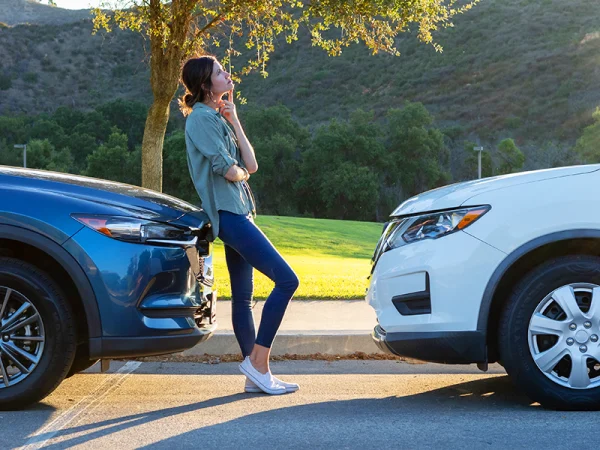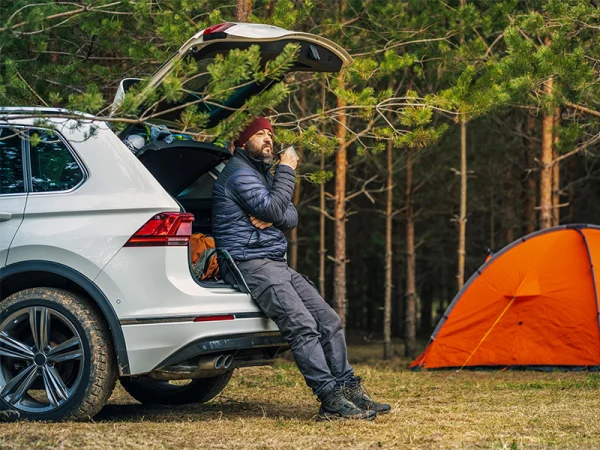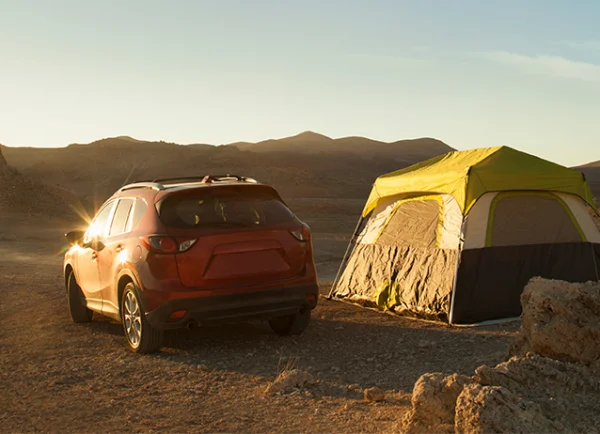2021 Subaru Forester review
Subaru Forester highlights
Customer rating
Pros
- Standard all-wheel drive enhances traction
- Comprehensive set of driver-assist features
- Spacious cargo capacity
Cons
- Engine lacks sufficient power
- Modest tow rating limits overall utility
- Child seat anchors are inconveniently placed
Mileage (EPA estimate)
26 city, 33 highway, 29 combined
Pricing for current inventory
(no current inventory)
Shop with your budget in mind
Getting pre-qualified lets you shop with personalized monthly payments, and it doesn't impact your credit score.
Add adventure to your daily drive
Adventure awaits you in the 2021 Subaru Forester. Powered by Subaru's famous symmetrical AWD, the Forester is ready to take you wherever roads may not. Practical touches like roof rails, split-folding rear seats, and durable materials make the 2021 Subaru Forester ideal for active living. Innovative technology and driving aids, combined with a peppy engine, can also make the 2021 Subaru Forester an ideal around-town vehicle. If you're looking for an SUV that's built for adventure and comfortably fits five, then check out what the 2021 Subaru Forester has to offer. While we currently do not have many 2021 Subaru Foresters on our lots, we look forward to selling more in the future. If you love the 2021 model, you should also consider prior model years of the Subaru Forrester with similar features.
All Subaru Forester years
Not sure what year to select? Learn about each Subaru Forester generation from 2012 to 2026
What is new for the 2021 Subaru Forester?
- Enhanced safety features including advanced driver assistance systems.
- Improved fuel efficiency ratings with updated engine options.
- Upgraded infotainment system with larger touchscreen and better connectivity.
- New trim levels available offering more customization options.
- Removal of less popular color options from the lineup.
2021 Subaru Forester trims
Curious how Subaru Forester trims differ? Use our side-by-side vehicle comparison to see the differences and similaritiesForester
Includes EyeSight driver assist technology, LED headlights, automatic climate control, 17-inch steel wheels, and more.
Premium
Adds X-Mode selectable drive mode, fog lights, raised roof rails, heated exterior mirrors, and more.
Sport
Adds LED fog lights, orange underguard accents, orange seat stitching, dual rear USB charge ports, and more.
Limited
Adds to the Premium trim with 18-inch alloy wheels, a power liftgate, leather-trimmed seats, an eight-inch touchscreen, dual-zone automatic climate control, and more.
Touring
Adds to the Limited trim with LED fog lights, driver seat memory seat, navigation, reverse automatic braking, LED interior lights, and more.
Subaru Forester photos
1. Legendary All-Wheel drive
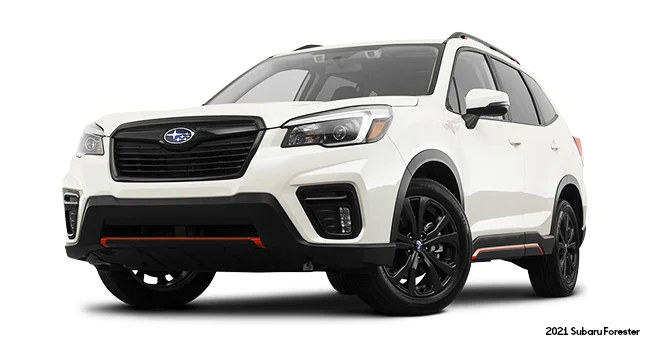
When the weather becomes less than ideal, having an intelligent AWD system on your side is a must. The 2021 Subaru Forester rides on the Subaru symmetrical AWD system, a gold standard in the industry. Power is automatically directed to the wheel with the most traction, giving you a confident grip in various situations. On the 2021 Subaru Forester Premium and higher trims, Subaru X-Mode® lets you fine tune the traction control to conditions like mud and snow.
2. Standard driving assist features
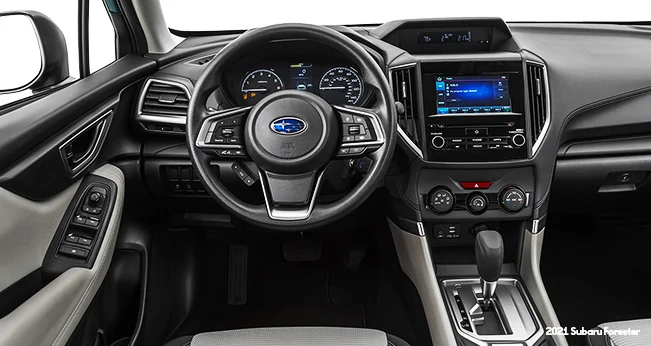
The 2021 Subaru Forester offers the driver assists you're looking for standard on every trim. Called EyeSight, this suite of systems includes forward pre-collision braking, throttle control, adaptive cruise control, and alerts. You'll stay centered on the road with lane centering, too.
3. Ready for any activity
You live an active life, never letting off the gas, and the 2021 Subaru Forester is designed to keep up. Raised roof rails are available or standard on several trims, giving you a quick and comfortable place to store longer items such as a surfboard or skis. A 60/40 split-folding rear seat lets you configure interior storage in many ways for other awkward items. An impressive 8.7 inches of ground clearance means the 2021 Subaru Forester can get you to your favorite trail, too.
4. Efficiency for the long run
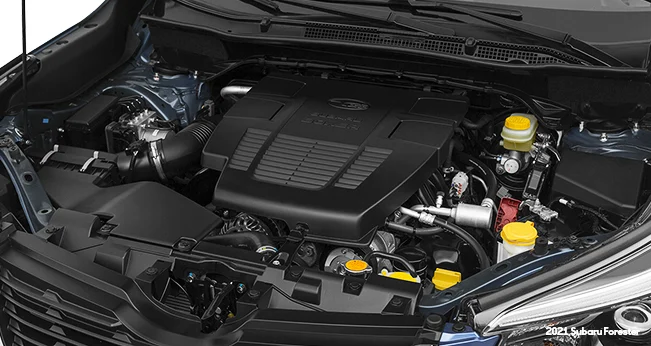
As capable and adventurous as the 2021 Subaru Forester is, you've also got everything you need for daily errands, weekend vacations, and lengthy road trips. Moving the 2021 Subaru Forester forward is a 2.5L four-cylinder engine producing 182 hp. The engine gets paired to a CVT with paddle shifters. All this technology combines to give the 2021 Subaru Forester an impressive fuel economy of an EPA-estimated 29 mpg combined.
5. The latest smart technology
Stay connected through the power of technology with your 2021 Subaru Forester. A smartphone app lets you remotely start and set the temperature on select trims.
Android Auto and Apple CarPlay connectivity is standard on the base-level 6.5-inch touchscreen infotainment system. A second 6.3-inch screen is standard on Sport and higher trims. It provides a rearview and trip information display, keeping the central infotainment screen open for your navigation or audio information. If you love to turn up the sound, an available nine-speaker Harmon Kardon audio system boasts 576W of power.2021 Subaru Forester video review
In this video, Desola Balogun from Edmunds reviews a 2021 Subaru Forester. Desola talks about everything that makes a used Subaru Forester one of our favorite compact SUVs. From its rugged attitude to its comfortable interior, the Forester has something for everyone to enjoy. Is a used Subaru Forester a good choice for your next used small SUV purchase? We're here to help answer this question and more in our review of the 2021 Subaru Forester.
Similar vehicles
If you're interested in the 2021 Subaru Forester, you should also check out these similar vehicles from Previous generation years.
Toyota RAV4
The Toyota RAV4 is a ruggedly handsome crossover SUV with seating for five passengers and is available with all-wheel drive (all models and years). Outdoor enthusiasts will especially like the Adventure trim package that debuted in 2018; it comes exclusively in all-wheel drive and includes a tow prep package. The RAV4 received a redesign in 2019 and includes five trim levels: LE, XLE, XLE Premium, Adventure, and Limited. For 2019, the Toyota RAV4 LE includes:
LED headlights
Rear View Camera
Bluetooth® connectivity
Apple CarPlay
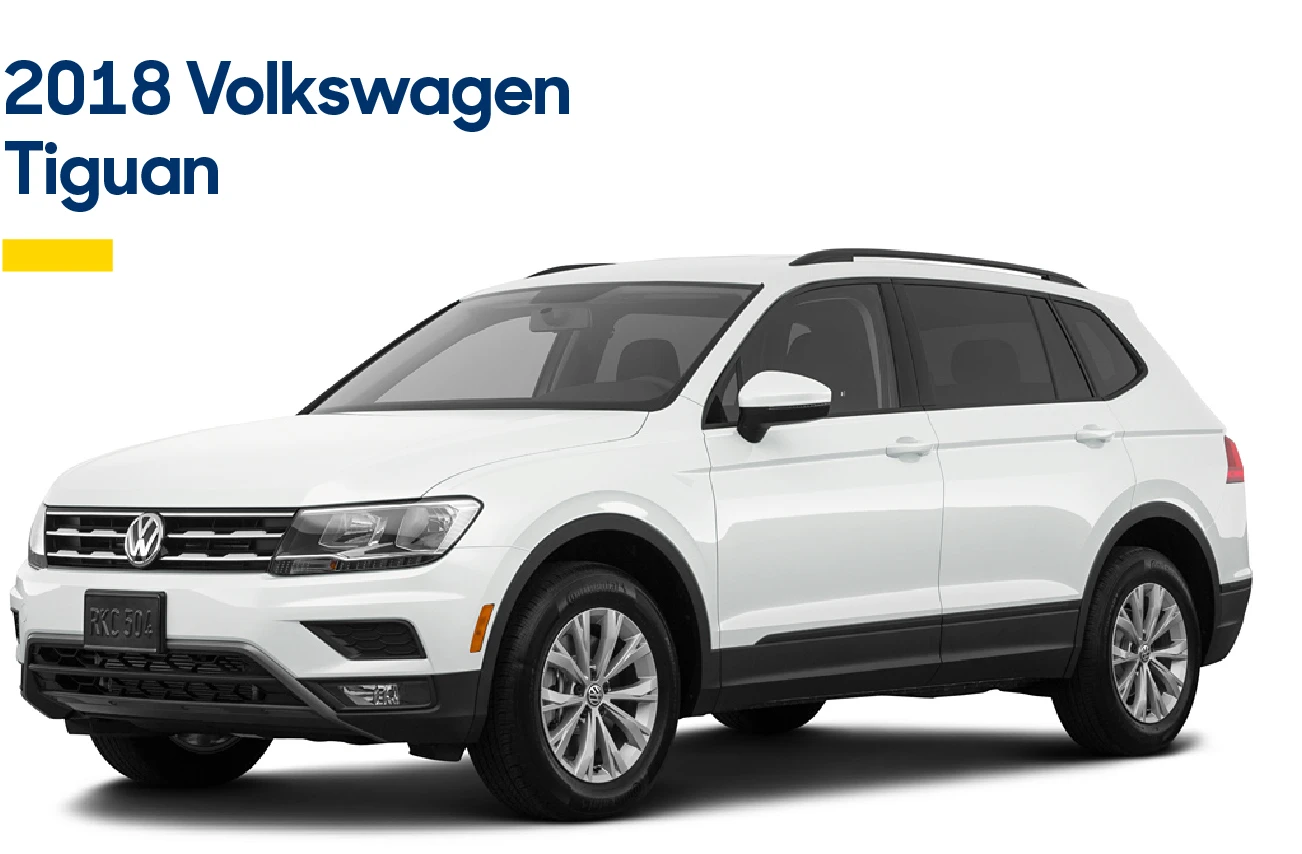
Featuring a classically Volkswagen exterior style and some impressive driver-focused features, the Volkswagen Tiguan is a crossover SUV that's refined and confident as a daily driver. The 2016–2017 models are part of the Tiguan's first-generation and feature a single engine option. The peppy, turbocharged 2.0L four-cylinder engine delivers 200-hp via a six-speed automatic transmission and standard front-wheel drive (all-wheel drive is available).
The 2018 and 2019 Tiguans are second-generation models that can boast of 10-inches of extra overall length and, should you need it, an optional third row of seating. All 2018–2019 Tiguans are motivated by a turbocharged 2.0L engine that pumps out 184 horsepower and 221 lb-ft of torque.
Standard features of the 2016–2019 Volkswagen Tiguan model include:
Bluetooth phone and audio connectivity
USB port
Roof rails
Apple CarPlay and Android Auto connectivity (from 2017)
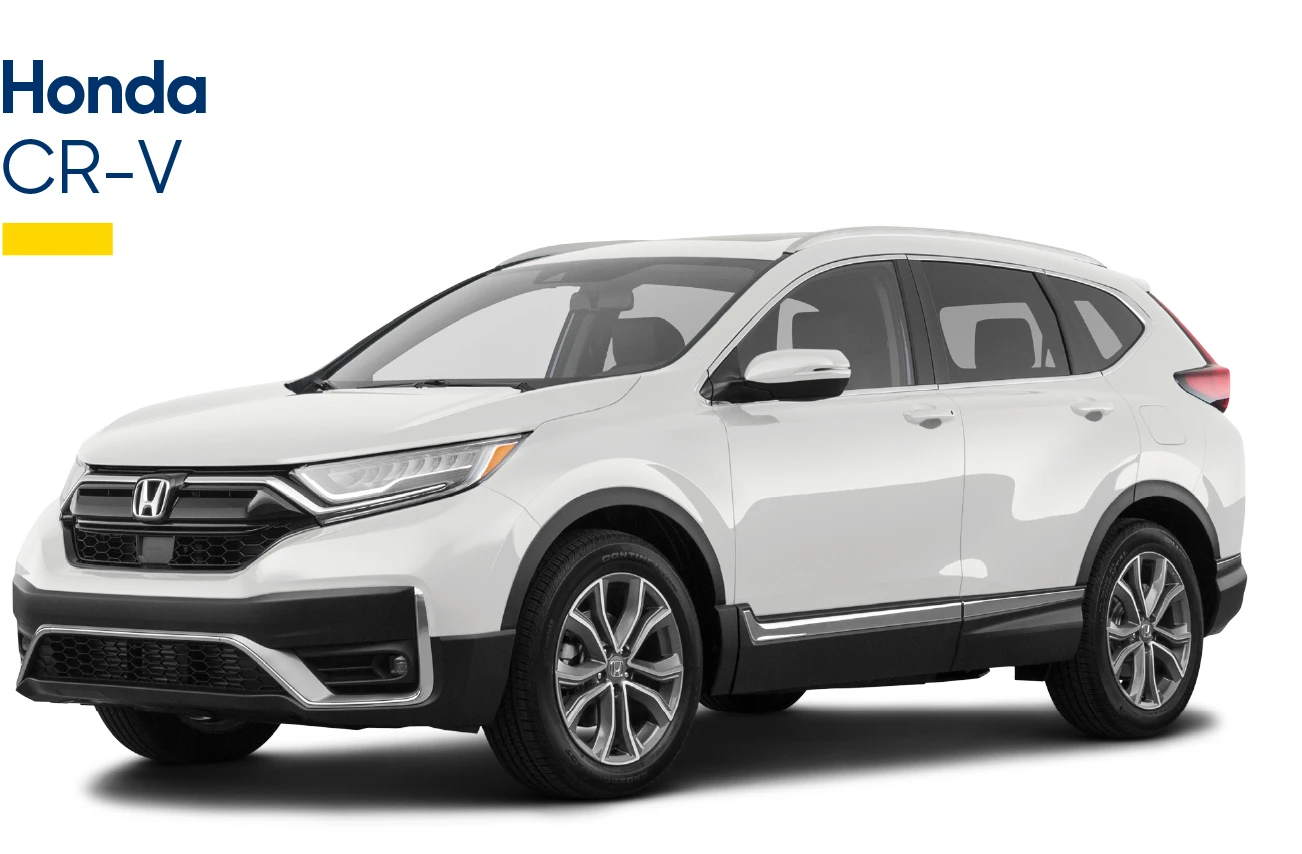
The Honda CR-V feels like a compact hatchback with extra cargo and ground clearance. The 2017-present Honda CR-V features easy handling that creates confidence on-road, while the optional AWD lets you power through tough weather conditions and muddy trails. The 2017-2019 CR-V packs a 2.4L four-cylinder engine under the hood, with an optional turbo 1.5L engine available for more power and torque. For 2020-present, the 1.5L is the sole engine choice.
Standard features on the 2020 Honda CR-V LX include:
17-inch alloy wheels
Automatic climate control
Bluetooth® connectivity
Shop with your budget in mind
Getting pre-qualified lets you shop with personalized monthly payments, and it doesn't impact your credit score.
Ratings & reliability
RepairPal gave the Subaru Forester an overall reliability rating of 3.5 out of 5 stars, which RepairPal describes as Above Average. This rating ranks Subaru Forester 22nd out of 29 among Compact SUVs.
View RepairPal's full rating of the Subaru ForesterSubaru Forester features and specs
Curious how Subaru Forester trims differ? Use our side-by-side vehicle comparison to see the differences and similarities
Touring 4D Sport Utility 4WD/AWD
Standard Features
- Front Seat Heaters
- ABS Brakes
- Rear Seat Heaters
- Traction Control
- Power Seat(s)
- Leather Seats
- Lane Departure Warning
- Memory Seat(s)
- Blind Spot Monitor
- Power Windows
- Power Locks
- Panoramic Sunroof
- Smart Key
- Power Mirrors
- Automated Cruise Control
- Air Conditioning
- Heated Steering Wheel
- Rear Defroster
- Side Airbags
- Rear View Camera
- Overhead Airbags
- Heated Mirrors
- Alloy Wheels
- Power Hatch/Deck Lid
- Automatic Transmission
- 4WD/AWD
- Harman Kardon Sound
- Navigation System
- AM/FM Stereo
- Satellite Radio Ready
- Bluetooth Technology
- Apple CarPlay
- Android Auto
- Auxiliary Audio Input
- CD Audio
- Remote Start
- Parking Sensors
- Tow Hitch
- Full Roof Rack
Drive Wheels
All Wheel (4WD/AWD)
Engine size
2.5L
Horsepower
182
Torque (ft-lbs)
176
Engine type
Gas
Fuel capacity
16.6
Wheelbase
105.1"
Overall length
182.1"
Width
71.5"
Height
68.1"
Leg room
F 43.3"/R 39.4"
Head room
F 40.2"/R 37.7"
Front tires
P225/55HR18
Rear tires
P225/55HR18
Seating capacity
5
Max towing capacity
150/1500 lbs.
Transmission
Automatic
2021 Subaru Forester FAQ
Every 2019-2021 Forester is equipped with a 2.5-liter four-cylinder engine making 182 horsepower and 176 lb-ft of torque. This is a decent amount of power but ultimately a bit short of what class leaders provide.
The engine is paired to a continuously variable transmission, or CVT. The big redeeming factor is that all-wheel drive comes standard on all Foresters. Also, the Forester has appealing EPA-estimated fuel economy for a small SUV with all-wheel drive: 29 mpg combined.
The Forester has a comfortable interior. The cabin is full of soft materials, tasteful plastics, and some genuine leather on higher trim levels. There are even rich upholstery colors and neat design accents to add some excitement to the fold. Most importantly, the Forester's raised height and large doors make it easy to get in and out. Also, the seats provide pleasing support for hours of driving, and there is a wide range of adjustments on the driver's seat and steering wheel to accommodate people of different shapes and sizes.
Space inside the cabin is another strength of the Forester. Front passengers should enjoy abundant headroom and legroom as well as an elevated seating position. The windshield pillars are quite thin and the windows are tall, allowing for an excellent view of the road and your surroundings.
More about the 2021 Subaru Forester
Color options
Exterior colors:
Crimson Red Pearl
Crystal White Pearl
Crystal Black Silica
Dark Blue Pearl
Horizon Blue Pearl
Ice Silver Metallic
Jasper Green Metallic
Magnetite Gray Metallic
Sepia Bronze Metallic
NHTSA Safety Ratings
The 2021 Subaru Forester received an overall 5/5 rating by the National Highway Traffic Safety Administration (NHTSA). Find out more about this rating and how NHTSA’s 5-Star Safety Ratings program evaluates the crash protection and rollover safety of new vehicles.
Keep in mind that certain vehicles may have unrepaired safety recalls. Click here to look up a specific vehicle.
Research other vehicles
- subaru forester used car value
- 1999 subaru forester used car value
- 2001 subaru forester used car value
- 2002 subaru forester used car value
- 2003 subaru forester used car value
- 2004 subaru forester used car value
- 2005 subaru forester used car value
- 2006 subaru forester used car value
- 2007 subaru forester used car value
- 2008 subaru forester used car value
- 2009 subaru forester used car value
- 2010 subaru forester used car value
- 2011 subaru forester used car value
- 2012 subaru forester used car value
- 2013 subaru forester used car value
- 2014 subaru forester used car value
- 2015 subaru forester used car value
- 2016 subaru forester used car value
- 2017 subaru forester used car value
- 2018 subaru forester used car value
- 2019 subaru forester used car value
- 2020 subaru forester used car value
- 2021 subaru forester used car value
- 2022 subaru forester used car value
- 2023 subaru forester used car value
- 2024 subaru forester used car value
- Used Subaru Forester near me for sale
- Used Subaru Forester 2.5XT Touring near me for sale
- Used 2021 Subaru Forester near me for sale
- Used 2024 Subaru Forester near me for sale
- Used 2025 Subaru Forester near me for sale
- Used Gray Subaru Forester near me for sale
- Used Subaru Forester Limited near me for sale
- Used 2020 Subaru Forester Limited near me for sale
- Used 2021 Subaru Forester Limited near me for sale
- Used 2022 Subaru Forester Limited near me for sale
- Used Subaru Forester with Memory Seat(s) near me for sale
- Used Subaru Forester with Navigation System near me for sale
- Used 2021 Subaru Forester Premium near me for sale
- Used 2023 Subaru Forester Premium near me for sale
- Used Red Subaru Forester near me for sale
- Used Subaru Forester with Remote Start near me for sale
- Used Subaru Forester Sport near me for sale
- Used 2020 Subaru Forester Sport near me for sale
- Used 2021 Subaru Forester Sport near me for sale
- Used 2022 Subaru Forester Sport near me for sale
- Used 2022 Subaru Forester Wilderness near me for sale
- Used 2023 Subaru Forester Wilderness near me for sale
- Used 2021 Gas Subaru near me for sale
- Used Subaru Forester SUVs near me for sale
- 2022 Audi Q5 Plug-in Hybrid review
- 2023 Audi Q5 Plug-in Hybrid review
- 2025 Audi SQ7 review
- 2013 BMW 750 review
- 2014 Cadillac Escalade review
- 2015 Cadillac Escalade review
- 2018 Chevrolet City Express review
- 2014 Chrysler 300 C SRT review
- All things EV
- Honda CR-V
- Used Subaru buying guide
- 2025 Subaru Forester review
- 2012 Subaru Forester review
- 2013 Subaru Forester review
- 2014 Subaru Forester review
- 2015 Subaru Forester review
- 2018 Subaru Forester review
- 2020 Subaru Forester review
- 2023 Subaru Forester review
- 2024 Subaru Forester review
- Toyota RAV4
We hope you found this information helpful. This content is intended to inform and is not meant to indicate that a particular vehicle is currently available or recommended for you.
Statements of fuel economy or EV range are based on EPA and other third-party estimates for vehicles when new. Fuel economy and EV range will degrade with time and vary based on age, driving conditions, vehicle history, and other conditions. See fueleconomy.gov for more info.
Unless otherwise noted, information related to featured vehicles comes from third-party sources, including manufacturer information. Product and company names may be trademarks or registered trademarks of third-party entities. Use of them does not imply any affiliation with or endorsement by these entities. By clicking on any video links, you will be taken to a third-party site maintained by YouTube, Inc.
We make every effort to provide accurate information, but please verify before purchasing.

